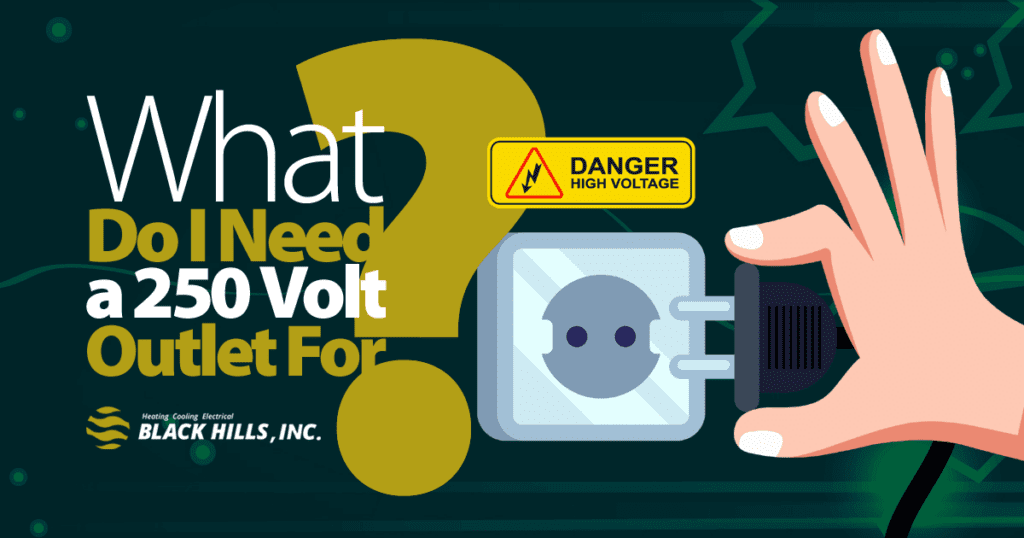As you walk through your home, most electrical outlets will be the standard ones you are used to. These are typically three-prong 120-volt, 15-amp outlets. One prong is the hot wire, another the neutral wire, and the third is the grounding wire.
You might see an occasional outlet that isn’t the same as the others. But some outlets are better suited for some purposes than others. Outlets come in many forms with different specifications. A 250-volt outlet has a higher capacity than the standard 120-volt, 15-amp outlet used to power lights and electronics that need only 110 volts.
What Is a 250-Volt Outlet?
A 250-volt, 20-amp outlet is used for high-power appliances. It can have three or four prongs and requires a double-pole circuit breaker installed in the main electrical panel. A double-pole breaker takes up two slots on the panel and is fed by both bus bars. There are 250-volt outlets with 30-amp and 50-amp power ratings to power equipment that requires even more power.
How Does a 250-Volt Outlet Work?
An appliance connected to a 250-volt outlet essentially has its own dedicated circuit (it’s said to be “hard-wired” if connected directly to the circuit wires). No other devices are connected, as the large appliance connected to it will likely meet the circuit’s capacity. Plugging additional items in would be a building code violation.
Smaller appliances need only one hot wire to operate. But in addition to the white neutral and bare copper ground wire, larger devices need two hot wires with a 250v outlet. The cable used must be appropriate for the amperage and be run from the breaker panel to the specific outlet box. Once the outlet is installed and wired to the panel, the appliance can be used.
What Are 250-Volt Outlets Used For?
There are a number of appliances, tools, and equipment that use 250-volt outlets. The two most common uses for 250v outlets are air conditioners and clothes dryers.
Air conditioners use a 250-volt outlet receptacle. The larger the unit, the more amps it will need; for example, 50 amps are sometimes required for large central AC units. A window AC unit may only need 20 amps.
An air conditioner circuit is usually wired with a nonmetallic (NM) cable, with a wire gauge appropriate for the amperage (20-amp circuits typically need 12-gauge wire, while 30-amp ones need a thicker 10-gauge wire). The lower the number on the gauge, the thicker and more expensive the cable is. Air conditioners take a lot of power to start up, but AC circuit breakers are designed to handle the surge in power without tripping.
Other 250v outlet applications are:
- Power tools
- Air compressors
- Water heaters
- Electric stoves
- Large ovens
- Welding equipment
Each of these tools and equipment can draw a lot of electrical power and requires larger cables, dedicated circuit breakers, and a 250v receptacle to operate. 220-volt tools can be plugged into 250v receptacles.
How to Wire a 250-Volt Outlet
When you purchase a new appliance, you may find it requires a 250V outlet. Installing and wiring a 250v outlet can be tricky. If you feel confident in your electrical wiring skills, read on. Otherwise, it might be best to hire a professional electrician.
To determine how many amps you need, check the product’s instructions. Then, you’ll need to purchase a breaker and cable with the appropriate amp rating; a 3-wire cable is needed for this type of application.
To install a 250-volt outlet, follow these steps:
- Run the cable from the panel to the outlet box where the plug will be installed.
- Remove about 6 inches of wiring jacket to separate the wires.
- Strip about a ½ inch of insulation so the copper wire is exposed.
- Connect the red and black wires to the terminal blocks labeled “hot” at the back of the outlet.
- Connect the white wire to the neutral black and copper ground wire to the ground block.
- Tighten the terminal screws on each to secure the wires.
- Screw the outlet to the outlet box.
- Verify the power is off at the breaker panel, then slide the new breaker into an empty slot. Slide the black and red wires into the terminal blocks on the breaker and tighten the screws.
- Slip the white wire into the neutral bus bar, tighten the screw, and do the same with the bare copper wire, which attaches to the ground bus bar. Now you can turn the power on and use the 250v outlet for high-power appliances.
When you need electrical panel work, it’s important to hire an electrician with the experience, training, and tools needed to provide repairs/updates safely. Our wiring experts can help increase electrical capacity and ensure your home is up to code.
Committed to your safety, we’re available 24/7 for electrical work and offer maintenance plans plus flat-rate pricing. We also offer flexible financing options. If you need a

